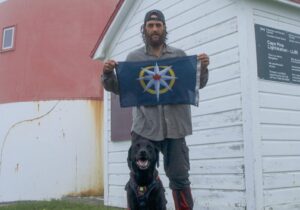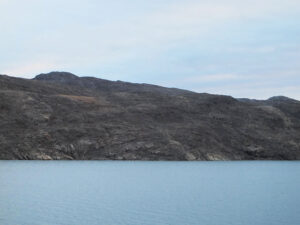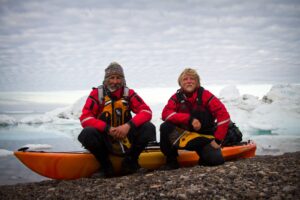For those with an interest in exotic cold-weather travel, the mind immediately jumps to Greenland, Antarctica or to regions bordering the Arctic Ocean. But equally interesting and more cost-effective destinations exist: Scandinavia, Alaska, Patagonia. An increasingly popular destination is Lake Baikal, just north of the Mongolian border, in the Siberian hinterland.
Baikal is the oldest, largest by volume and deepest lake in the world. In some places, it’s more than 1.6 kilometres deep and holds one-fifth of the world’s freshwater. Its 640km length is the same as the distance from London to Edinburgh. And for a few months a year, it freezes completely, allowing hardy souls the opportunity to drive, ski, skate, snowshoe or walk across its surface.
In this in-depth guide, ExWeb explores this frozen Russian gem.

Crossing patches of bare ice and snow. Sometimes, you have kilometre after kilometre of this bare ice: Heavy sleds then haul like nothing, and skating becomes the most efficient mode of travel. Photo: Felicity Aston
The Conditions
Historical data collected over the past 150 years shows that Baikal begins to freeze in December-January. The past 10 years of NASA satellite imagery indicates that the lake is fully frozen from mid- to end-February until the middle of April.
Northern parts and shallow bays freeze early, especially opposite Olkhon island. “People who love ice skating go to the Olkhon area beginning in mid-December”, says local guide Eugene Kaplunenko. By early April, ice in the south begins to break up. This takes another two to three weeks further north. Says Kaplunenko: “In northern Baikal, people go ice-fishing in the first week of May, whereas in the south we already have open water.”

Snow cover varies from year to year. In 2016, for example, most of the lake was snow covered. Typically, more snow falls in the north, after the halfway point of Olkhon Island. Photo: Tim Moss/Next Challenge
In colder winters, the ice in the north can reach a thickness of 100 to 110cm, while in the milder south, 60 to 70cm is the typical maximum. (In years with deep snow, the ice tends to be a little thinner.) The ice is usually thick enough to drive vehicles on, although every year, local rangers have to fish out a few that have broken through!
Now and then, there are leads (fissures of open water, typically no more than two meters wide, but sometimes up to four) that require navigating around or across. The larger ones typically recur in the same spots, such as between capes, year after year.

A lead running into the distance. These smaller cracks in the ice can be easily vaulted and provide drinking water without melting snow or ice. Photo: Scott Gilmour/weatherised.com
The average air temperature in February-March hovers around -15 to -20C, although it can plummet to -40 in the north. Winds often rage on Baikal. There are a number of prevailing winds, blowing from the large valleys, mountains or rivers that line the lake, which you can read about here.

Ice hummocks known locally as toros line much of the coastline and can also form in the middle of the lake, when wind breaks up ice pieces during the freezing process. These fields can be kilometres wide and force long detours or painfully slow going. Photo: Scott Gilmour/weatherised.com
The amount of snow dictates the best mode of travel. In some years, such as 2016, the lake is largely snow-covered, and skis or snowshoes are a must. More often, Baikal combines large stretches of bare ice with occasional snow patches. The section north of Olkhon Island (see map below) has more snow. On bare ice, microspikes on boots are required, although on larger sections, ice skating covers distance far more quickly, at the risk of injury from catching a blade in a hidden crack.
If you can hit one of the ice roads created by local vehicles, you’ll be on compact snow or ice, in which case progress is likewise great.

Lightweight ice cleats or microspikes give traction on the ice. Mountain snowshoes with integral crampons are a good compromise on mixed snow and ice. Photo: Scott Gilmour/weatherised.com
Logistics
Compared to most subarctic destinations, Baikal is relatively easy to get to. You can fly from Moscow to Irkutsk, which is 100km from the starting point of a full-length Baikal crossing. Irkutsk is a city of over 500,000 people, and you can pick up clothing, plastic pulks, snowshoes, stoves, knives, boots, fuel and most foods, although don’t count on locating white gas, dehydrated meals or specialized polar equipment.

The classic Baikal crossing route. Irkutsk is shown in the red circle. Photo: Ash Routen
For around 100 euros, local guides will ferry you to the starting points of either Kultuk or Sludyanka. If you are looking to shave a few days off of your trip, you can start a little further up the coast at the tourist resort of Listvyanka.
A full crossing via the classic route finishes at either Niznheangarsk or 25 km south at Severobaikalsk. It takes most manhaulers 20 to 30 days to cover the 640km.
A few teams start in the north. Although this gives some advantage with more tailwinds than headwinds, it’s generally more popular to begin in the south, where ice breakup first occurs.
From Severobaikalsk, a 36-hour train ride on the BAM railway — a northern alternative to the fabled Transsiberian — conveys tired manhaulers back to Irkutsk. You can put your feet up and enjoy the snowy Siberian wilderness scroll past your window.

A remote dwelling on Olkhon Island. Locals are happy to house visitors for an overnight stop. Photo: Pxfuel.com
The People
A few small communities line the shores of Baikal, with larger settlements found at Olkhon Island or Ust-Barguzin on the east coast. Although one British team had to deal with drunken locals looking to cause mischief out on the ice, it’s unlikely to meet a more welcoming or warm people. They often stop their vehicles to ask if you want a lift, or simply to ply you with the local samagon, or moonshine.
Baikal means a lot to the local population. It’s their home and source of livelihood, through fishing, tourism etc. And to the shamans and indigenous Buryat people, it’s one of the most sacred places on earth.
I spent my entire childhood on the shores of Baikal (my grandmother lived in a tiny village in the south of the lake) and today when I happen to be on the lake I physically feel how the positive energy of Baikal recharges my batteries. For me it is not just the biggest freshwater lake – it is part of my inner world. Several times in my life I got attractive job offers but that would mean moving to another city and even another country. Every time I refused.
Eugene Kaplunenko, Irkutsk-based Baikal guide
In 2008, Britons Felicity Aston and Jenny Pugh spent some time with the Buryat people as part of a meandering crossing of the lake.
The Equipment
The usual polar gear is required, with one or two add-ons due to the specific conditions on Baikal: ice screws to stake the tent to the ice, multiple pairs of microspikes to walk on slippery bare ice, synthetic or hydrophobic down sleeping bag with an outer bag, as the lake is surprisingly humid, a climbing axe to chip ice for melting and hammer in/remove ice screws, a high-quality tunnel tent or double-poled geodesic tent against the high winds and snowshoes or skis with short kicker skins. Beware taking cheap thin plastic pulks: The rough ice can slice open the bottom of the pulk, as Felicity Aston discovered in 2008.
A satellite phone is also desirable, as a mobile signal can’t be relied upon. A coastal road runs for the first half of the lake, but after that, rescue may take a number of days.

Michael Stevenson (GBR) near a small pressure ridge commonly found on bigger lakes like Baikal. Photo: Scott Gilmour/weatherised.com
The Expeditions
Although it would be arrogant to assume that locals have not crossed Baikal themselves, no public records exist of their feats. ExWeb has done its best to compile a working database of the nearly 30 expeditions that have taken place to date.
In a translated expedition report from 2007, Russian Alexandr Semenov suggests that in 2000, Janusz Bochenkem from Poland walked an unknown route across Baikal for 63 days. He also suggests that Frenchman Michel Gilles traveled on foot from Kultuk to Severobaikalsk in 12 days, later abandoning the return journey after falling through the ice. Neither of these reports can be confirmed. In another report, Gilles’ journey is listed as 24 days.
The first crossing with any sort of paper trail was made by German’s Stefan Wackerhagen and Stephan Reichelt in 2003. They finished their journey a little shy of the true northerly finish at Nizhneangarsk, so what might be called the first full traverse of Baikal seems to belong to polar veterans Conrad and Hilary Dickinson, on their 21-day traverse in 2007.

The current speed record holders: Michael Stevenson, Scott Gilmour and Rob Trigwell. Photo: Scott Gilmour/weatherised.com
In 2010 Canadians Ray Zahab and Kevin Vallely set a time of 13 days and 16 hours for a full traverse. Earlier this year, the British trio of Michael Stevenson, Scott Gilmour and Rob Trigwell bettered that with a time of 12 days, 21 hours and 13 minutes.
Rather than walk, some teams decide to skate or even cycle, as Briton Jonny Mutch did in 2017.
Remarkable soloists include Irish adventurer Gavan Hennigan, who made a full crossing in 17 days, and Russian Alexander Semonov: In 2007, Semonov skied and skated a circumnavigation of Baikal from Listvyanka to Listvyanka, a total of 1,850km in 36 days. He seemingly had some support along the way, but details of his journey are limited.
If a full-length trip isn’t your thing, you could do what Laura and Tim Moss of the UK did in 2017, a four-day, 100km west to east crossing from Olkhon Island to Ust-Barguzin.
The Future
In 2019, five separate teams plan to set out on the ice, including the British trio of Gilmour, Stevenson and Trigwell, who hope to bring the speed record down still further.
The last great challenge on Baikal is a fully unassisted and unsupported circumnavigation of the lake. As yet, it remains unattempted. It would likely take 35 to 45 days and require ideal ice conditions and a strong team.
Good ice conditions won’t persist forever, even on this continental Siberian lake. According to recent data, Baikal is undergoing considerable change from the warming climate. Sadly, winters are becoming milder and ice cover thinner and will likely become less pervasive as the years go by.
For now, however, adventurers still flock to this hidden pearl of Siberia known affectionately to those who live along its shores as “the Old Man”.
Acknowledgements and Links
Thank you to Eugene Kaplunenko of A-B Tours for his assistance in preparing this article.
Large-Scale Climatic Controls on Lake Baikal Ice Cover
Climate Change and the World’s “Sacred Sea”—Lake Baikal, Siberia
Sixty years of environmental change in the world’s largest freshwater lake – Lake Baikal, Siberia





